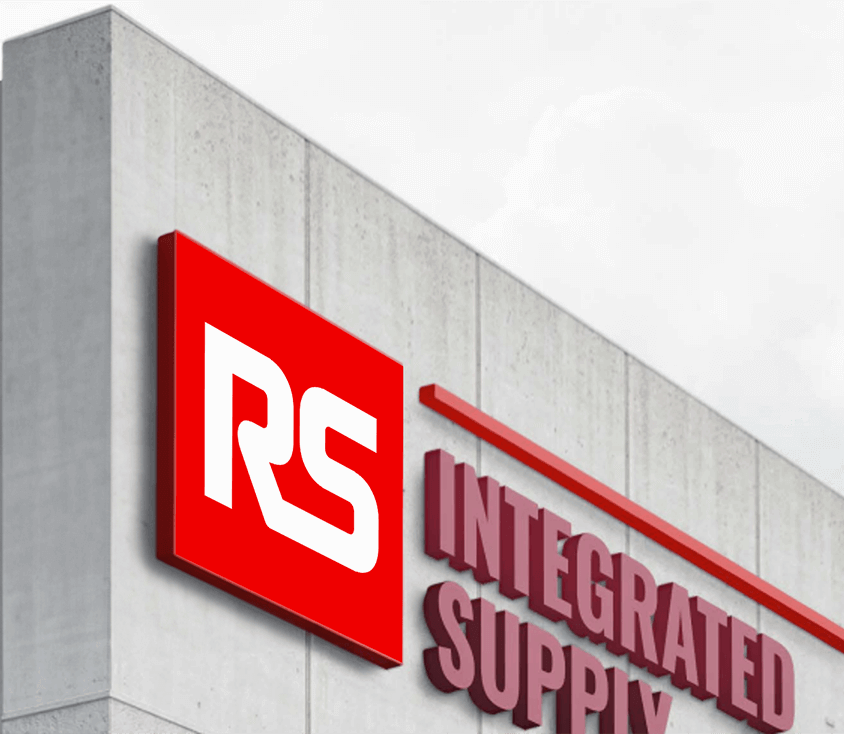Published on
Read time: 8 minutes

“Artificial intelligence (AI) is much more than a ‘buzz phrase’,” reported global consultancy firm EY, recently. On the contrary, this technology “is set to have a deep and wide impact across industrial sectors.” Here, we explore its impact on one specific area of industry: the maintenance, repair, and operations (MRO) supply chain.
Multi-Generational Technology
Organizations are deploying the technology in a variety of ways, says EY, with industrial companies already “using traditional AI approaches such as machine learning.” Examples of machine learning in action include analysis of data and making predictions based on that data. Generative AI, or GenAI, is more advanced and used in developing new content. Its recent rapid adoption, continues EY, “has raised awareness of AI’s capabilities and potential to transform and disrupt.”
“Machine learning is not a new technology,” says Caroline Joseph, Director of Global Business Insights at RS Integrated Supply, an international provider of MRO procurement and supply chain management. “Companies have been using data to make decisions for many years. What is new is having self-sufficient models and having AI to bring together multiple data sets that would have been in silos.”
These developments mean businesses are on a learning curve, adds Robert Kline, Chief Technology Officer at RS Integrated Supply. “Whereas AI models used to be rather basic in terms of their predictive abilities, now generative AI can synthesize data and be trained on enormous volumes of data. Companies are trying to figure out how to use this in a business context and what problems it can solve.”
Data is King
The advances in AI are driven by “the availability of data, increased computational power and the development of better AI algorithms,” says Kline, with data being particularly important. “Data is critical to training these models. The starting point for a lot of organizations is to capture their data and organize it so they can leverage the power of AI, additionally they can use AI to enhance the data itself.”
“You cannot do analytics without data,” Richard Jeffers, Solutions and Technical Director at industrial and electronic solutions provider RS UK and Ireland, a sister company to RS Integrated Supply. “In order to do any sort of mass data manipulation, you need streaming telemetry data that’s relevant to the process. The expansion of sensors and interoperability between sensors as well as the ability to extract data out of devices and get it into a single place, normally in the cloud, is the precursor to do anything clever.”
But get the fundamentals right first
Success depends, however, on having a solid foundation to build upon. “What you do with the data is the next step, but you still need to get the basics right,” continues Jeffers. “A well-run manufacturing facility is one that’s doing the basics of process, restoration, and good practice. You don’t need large datasets to do that. If you do have large datasets but aren’t doing those fundamentals well, then that data is pretty useless – but if you’re already doing all the basics well, then the ability to manipulate data at scale is very important.”
Brandon Coombs, Senior Vice President of Operational Excellence at RS Integrated Supply, sees this play out. As he observes, “The journey with AI machine learning correlates with business process maturity. If a company is at a high level of maturity, they’re building on the foundational elements to make this dream a reality, whereas organizations on the lower end of the maturity spectrum have a lot of processes and data that is unlikely to be measured or fully understood, impeding the ability to reap the full benefits of what AI offers.”
Adapting and Improving
One area of opportunity is the supply chain. “The supply chain has existed for centuries and has always leveraged new technologies to adapt and improve,” states EY. “Today, supply chains that are more resilient, more cost-effective and more predictable are AI-enabled supply chains.”
How does AI technology strengthen MRO supply chains? “Let’s start off with the demand side,” says Jeffers. “If you’ve got the right data with the right leading indicators of failure on a component being monitored then you can start to see potential failure before it occurs and act accordingly. That’s great for organizations because you can schedule for the right stock to arrive when you need it. I see a real benefit in terms of reducing stock errors and stock outs.”
Those responsible for MRO can also gain a more accurate picture of existing inventory. “Every facility I’ve ever been involved with has a mass of spare parts with random nomenclature,” laments Jeffers. “The ability to identify those parts by entering the data into a large language model leads to massive savings in terms of labor and replacing components.
“Let generative AI work out where the patterns are – then you can start to understand obsolescence and different naming and numbering conventions across sites. You’ll get more utility out of the working capital and more value out of your spare parts. That can be a real force multiplier.”
The Tools Are Out There
AI-based services and solutions are already available on the market. Take SnapPartTM. “We’ve combined AI with mobile technology to create a tool that can easily be used in the storeroom to rapidly identify parts using an app,” explains Kline. “It uses text recognition, web search, voice recognition and barcode scanning.”
Recent implementation projects demonstrate that thanks to its versatility, SnapPartTM reduces data collection times by up to 50% while also improving data accuracy. Tying parts to specific categories helps procurement to identify savings opportunities by introducing different suppliers at lower price points too.
In one organization, for example, RS Integrated Supply verified 8,837 items, with 43% improvement in manufacturer’s name and 60% improvement in manufacturer part number. Product classifications and image usage reached 100%. Within a month, the buying team saw a significant reduction in non-conformance relating to the sourcing and delivery of parts. This means fewer returns and supplier restocking fees, improved on-time in-full delivery performance, and, with fewer stock outs caused by delivery of incorrect parts, enhanced stock availability.
“Where my team have implemented SnapPartTM, we have cut waiting times and delays, speeding up the process. It’s proved to be beneficial and a robust tool,” says Coombs. The same is true when using RS SyncTM, a cloud-based MRO purchasing and supply chain management tool. “With RS SyncTM, we see productivity increase because we can process transactions much more quickly. We can be more efficient, safer, and provide more value.”
“The implementation of marketplace technology with RS SyncTM provides customers with a unique e-commerce experience,” says Kline. As well as making it easier to find and order parts, RS SyncTM utilizes AI to “improve customer data and introduce customers to new ways to leverage that data.
“We’ve been able to better advise them in areas such as inventory optimization and provide greater visibility and transparency around the metrics that they need from their business. The availability of data and our ability to share it with customers in a standardized way so they can get the most out of the integrated supplier program has been really meaningful.”
The Benefits of Collaboration
Integrators also bring value by providing expertise and experience that may be difficult to secure in-house given that, as EY reports, “industrial companies’ AI ambitions risk being stalled by a lack of suitable technology talent.”
Since few organizations have the resources available for all required skill sets, collaborating with a third party offers a solution. It is the specific level of expertise that itself provides value by understanding and addressing the challenges involved.
“We provide end-to-end services,” agrees Joseph. “We support plans, implementation, and data summarization. We will handle procurement as well as billing and charging processes. It’s our objective to deliver the best value and we use the power of data and analytics to do that. As a customer, you have access to huge datasets, which is critical when it comes to analytics, AI, inventory optimization and storage management. It is really powerful for our clients.”
“What will be needed? When? And what are the risks if we do not have it? These are the key decisions,” adds Coombs, “and integrators are a one-stop shop for all this information. We can help with the central element of the data itself and offer a holistic service package thanks to our relationships with suppliers and our ability to standardize and normalize data. All the things we already do create the foundation for this.
“I see AI as vital to our role because as an integrator, our job is to ensure parts arrive from point A to point B as efficiently and accurately as possible. The more we use and develop AI to predict, streamline, and automate core processes, the more value we bring to our customers – so the incentive for us is very high.”
Unlocking AI’s Full Potential
Looking ahead, how will AI support MRO supply chains in the future? For Coombs, it is about figuring out how to scale AI to unlock its full transformational potential. “There’s a lot of organizational change within industry needed,” he argues. “Although the technology exists, without the enabling structures and core processes in place, it becomes very difficult to realize the benefits. Businesses need to say this is who we are, and these are the strategic goals to determine the role of AI in improving process capabilities.”
A simplified example of the potential is “instead of having thousands of MRO suppliers, you have one who knows what you have in stock and has real-time data from suppliers about lead times as well as vital information related to asset and material risk, predictive maintenance analytics, material consumption patterns and so on. By leveraging this data, more advanced algorithms can be created to optimize inventory strategies and ensure maximum available uptime for the customer. As the process improves, so does cash flow as less expenditure and waste are likely to occur purchasing so-called just-in-case materials. A lot of work, of course, needs to happen behind the scenes to bring all of this to life.”




